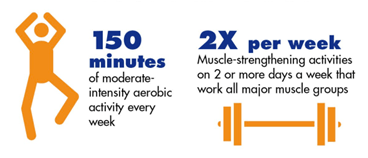Exercise for disabilities
Data on the amount of exercise that people with disabilities engage in can vary depending on the source, the population studied, and the definition of "disability". However, some studies have found that people with disabilities tend to be less active than those without disabilities.
According to the Australian Bureau of Statistics (ABS) 2019 Survey of Disability, Ageing and Carers, people with a disability are less likely to meet physical activity guidelines compared to people without a disability.
The survey found that 47% of people with a disability aged 15-64 years engaged in some form of physical activity in the previous week, compared to 68% of people without a disability. Additionally, only 27% of people with a disability aged 15-64 years engaged in sufficient physical activity to meet the Australian Physical Activity Guidelines (at least 150 minutes of moderate intensity physical activity or 75 minutes of vigorous intensity physical activity per week), compared to 44% of people without a disability.
The survey also found that physical activity levels varied depending on the type and severity of disability. For example, people with a profound or severe core-activity limitation were less likely to engage in physical activity compared to people with a mild or moderate limitation.
A study conducted by the Centres for Disease Control and Prevention (CDC) in 2017 found that only 18.5% of adults with a disability met the Physical Activity Guidelines for Americans, compared to 29.2% of adults without a disability. This suggests that people with disabilities are less likely to engage in regular physical activity.
A study by the World Health Organisation (WHO) in 2011, showed that adults with disabilities are more likely to be physically inactive that adults without disabilities. People with disabilities were found to be nearly twice as likely to be physically inactive than those without disabilities.
Additionally, a study by the National Center on Health, Physical Activity and Disability (NCHPAD) found that adults with disabilities engage in fewer minutes of moderate-to-vigorous physical activity (MVPA) per week than adults without disabilities. The study also found that adults with disabilities were less likely to engage in regular physical activity than adults without disabilities.
It's important to note that these studies may have different definitions of disability and may not include all disabilities, so the numbers may not be applicable to every person with a disability. Also, the numbers may vary based on the type of disability, the severity of the disability, and other factors. Further research is needed to better understand the barriers and facilitators to physical activity among this population. However, the findings highlight the importance of promoting and supporting physical activity among people with a disability to improve their health and wellbeing.
In summary, while data on the exact amount of exercise that people with disabilities engage in can vary, studies suggest that people with disabilities tend to be less active than those without disabilities and that they engage in fewer minutes of moderate-to-vigorous physical activity per week. Get motivated and contact our team of fun and friendly Perth Exercise Physiologists today!
